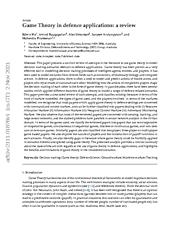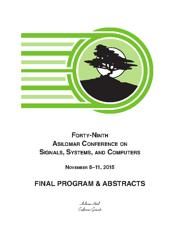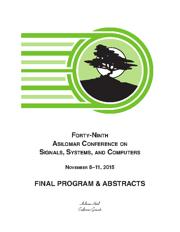A copy of this work was available on the public web and has been preserved in the Wayback Machine. The capture dates from 2019; you can also visit the original URL.
The file type is application/pdf.
Filters
Game-Theoretic Power Allocation and the Nash Equilibrium Analysis for a Multistatic MIMO Radar Network
2017
IEEE Transactions on Signal Processing
ACKNOWLEDGMENT The authors would like to thank the Associate Editor and all the reviewers for their very valuable and insightful comments during the revision of this work. ...
Abstract-We investigate a game-theoretic power allocation scheme and perform a Nash equilibrium analysis for a multistatic multiple-input multiple-output radar network. ...
Index Terms-MIMO radar, power allocation, game theory, multistatic radar, Nash equilibrium, noncooperative game.
I. ...
doi:10.1109/tsp.2017.2755591
fatcat:o5m2o6dmxvhx3oxkzvecnkxj4e
Stackelberg Game-Theoretic Low Probability of Intercept Performance Optimization for Multistatic Radar System
2019
Electronics
Then, the Nash equilibrium (NE) for the considered game model is derived, and the existence and uniqueness of the NE are analytically proved. ...
In this paper, the problem of Stackelberg game-theoretic low probability of intercept (LPI) performance optimization in multistatic radar system is investigated. ...
Conflicts of Interest: The authors declare no conflict of interest. ...
doi:10.3390/electronics8040397
fatcat:gjysavmnbnanpaphpcrlpr3474
Power allocation for target detection in radar networks based on low probability of intercept: A cooperative game theoretical strategy
2017
Radio Science
Acknowledgments We note that there are no data sharing issues since all of the numerical information is provided in the figures produced by solving the equations and iterative procedure in the paper, which ...
The MATLAB programs and numerical data are available upon request to the first author (scg_space@163.com). This work is supported in part by the National Natural Science Foundation of China ...
In Deligiannis and Lambotharan [2017] , a Bayesian game-theoretic SINR maximization and power allocation algorithm is proposed for a multistatic radar network system, where the primary goal of each radar ...
doi:10.1002/2017rs006332
fatcat:qdsoyoe4jjcdte7xb4fl2uv3cq
Multiple Power Allocation Game Schemes for Spectrum Coexistence Model Between Multistatic MIMO Radar Sensors and MU Communication
2020
Sensors
A supermodular power allocation game (PAG) model is established and the existence and uniqueness of the Nash equilibrium (NE) in this game are proved. ...
This paper uses game theory to study power allocation problems between multistatic multiple-input multiple-output (MIMO) radars and downlink communication. ...
Acknowledgments: The authors would like to thank the anonymous reviewers for their valuable and insightful comments and suggestions, which helped improve this paper. ...
doi:10.3390/s20216216
pmid:33142670
fatcat:jnhg3squuvhy5gapcekdbgnxdi
Adaptive Energy Efficiency Based Power Allocation for MIMO Radar Network
2019
VOLUME-8 ISSUE-10, AUGUST 2019, REGULAR ISSUE
The performance of the EEPA-GLRT methodology is compared with Generalized Nash Game (GNG) method and it shows the power consumption of EEPA-GLRT is 0.0549 for cluster 1 of scenario 1, which is less when ...
In this paper, an Energy Efficiency based Power Allocation (EEPA) is used to allocate the power to a user of the clusters and also across the clusters. ...
In this MIMO radars, the power allocation is performed by game theory and Nash equilibrium analysis is used for the multistatic MIMO radar system. ...
doi:10.35940/ijitee.a5189.119119
fatcat:azqr2gc3xbgmlkt4u3oo5rqrg4
Radar Waveform Strategy Based on Game Theory
2019
Radioengineering
Different game waveform strategies are designed for different information levels of radar and jammer. ...
Signal-to-Interference-plus-Noise Ratio (SINR) criterion is used in formulating the utility functions. The existence of Nash equilibrium in games is verified by mathematical derivation. ...
In later work conducted by Panoui and Deligiannis, the power allocation schemes of Multistatic MIMO radar network based on different game models were investigated. ...
doi:10.13164/re.2019.0757
fatcat:6z42spt24vatdpbuwzeis5ztau
Game theoretic analysis for MIMO radars with multiple targets
2016
IEEE Transactions on Aerospace and Electronic Systems
game theoretic analysis for the optimal beamforming and resource allocation problem in a MIMO tracking radar system with multiple targets. ...
CONCLUSION We have investigated a game theoretic approach to tackle the problem of joint beamforming and power allocation in a distributed radar network. ...
doi:10.1109/taes.2016.150699
fatcat:ov2ff5i2d5aobadn3ot56efsse
Game theoretic distributed waveform design for multistatic radar networks
2016
IEEE Transactions on Aerospace and Electronic Systems
Game theoretic distributed waveform design for multistatic radar networks. ...
ACKNOWLEDGMENT The authors wish to thank the Associate Editor and all the reviewers for their very valuable and insightful comments during the revision of this work. ...
CONCLUSION We have proposed a game theoretic waveform allocation method for a network of multistatic radars. ...
doi:10.1109/taes.2016.150378
fatcat:6yfu76ko4nap7pw76wscu2m3tu
Nash Bargaining Game-Theoretic Framework for Power Control in Distributed Multiple-Radar Architecture Underlying Wireless Communication System
2018
Entropy
This paper presents a novel Nash bargaining solution (NBS)-based cooperative game-theoretic framework for power control in a distributed multiple-radar architecture underlying a wireless communication ...
An iterative Nash bargaining power control algorithm with low computational complexity and fast convergence is developed and is shown to converge to a Pareto-optimal equilibrium for the cooperative game ...
Acknowledgments: This research is supported by the Fundamental Research Funds for the Central Universities (Grant No. NS2016043). ...
doi:10.3390/e20040267
pmid:33265358
fatcat:uvml4tml2fc3nbtmwzsbvuwifa
Game Theory in Defence Applications: A Review
2022
Sensors
We also observe that most of the reviewed papers are concerned with sensing, tracking, and large sensor networks, and the studied problems have parallels in sensor network analysis in the civilian domain ...
The presented analysis provides a concise summary of the state-of-the-art with regards to the use of game theory in defence applications and highlights the benefits and limitations of game theory in the ...
Funding: This research was funded by Defence Science and Technology Group, Australia under a STaRShot grant to MP. The The APC was funded by the Defence Science and Technology Group, Australia. ...
doi:10.3390/s22031032
pmid:35161778
pmcid:PMC8838118
fatcat:uov55npma5hmpbdiyjbseto4di
Game Theory in defence applications: a review
[article]
2021
arXiv
pre-print
The presented analysis provides a concise summary about the state-of-the-art with regards to the use of game theory in defence applications, and highlights the benefits and limitations of game theory in ...
This paper provides a structured review of such attempts, and classifies existing literature in terms of the kind of warfare modelled, the types of game used, and the players involved. ...
Farhan Faruqui from the Defence Science and Technology Group, Australia for many fruitful discussions
Conflicts of Interest: The authors declare no conflict of interest. ...
arXiv:2111.01876v1
fatcat:wol5ggeg6rbazg7wnpcix6boae
Implementation of Fog computing for reliable E-health applications
2015
2015 49th Asilomar Conference on Signals, Systems and Computers
In this work we explore some of the potential fiber-optic data transmission applications of the nonlinear Fourier transform (NFT), a signal analysis technique introduced by mathematicians and physicists ...
Specifically, we introduce a concept for sparse joint activity, channel and data detection in the context of the Coded ALOHA (FDMA) protocol. ...
A sufficient condition is presented on the asymptotic pairwise frequency of players' strategy updates under which the asynchronous FP play process is shown to converge to Nash equilibrium in games known ...
doi:10.1109/acssc.2015.7421170
dblp:conf/acssc/CraciunescuMMKP15
fatcat:qm6mki5z6bcvrfimkmqjyrxaxm
Ping-pong beam training for reciprocal channels with delay spread
2015
2015 49th Asilomar Conference on Signals, Systems and Computers
We address the problem of designing a waveform for Multiple-Input Multiple-Output (MIMO) radar under the constant modulus and the waveform similarity constraints. ...
In this paper, we conduct sensitive analysis of the optimized waveforms used in a MIMO-MC scenario in which targets fall in different range bins. ...
A sufficient condition is presented on the asymptotic pairwise frequency of players' strategy updates under which the asynchronous FP play process is shown to converge to Nash equilibrium in games known ...
doi:10.1109/acssc.2015.7421451
dblp:conf/acssc/CarvalhoA15
fatcat:mqokuvnh3zg45licnfbgxyvxfu













